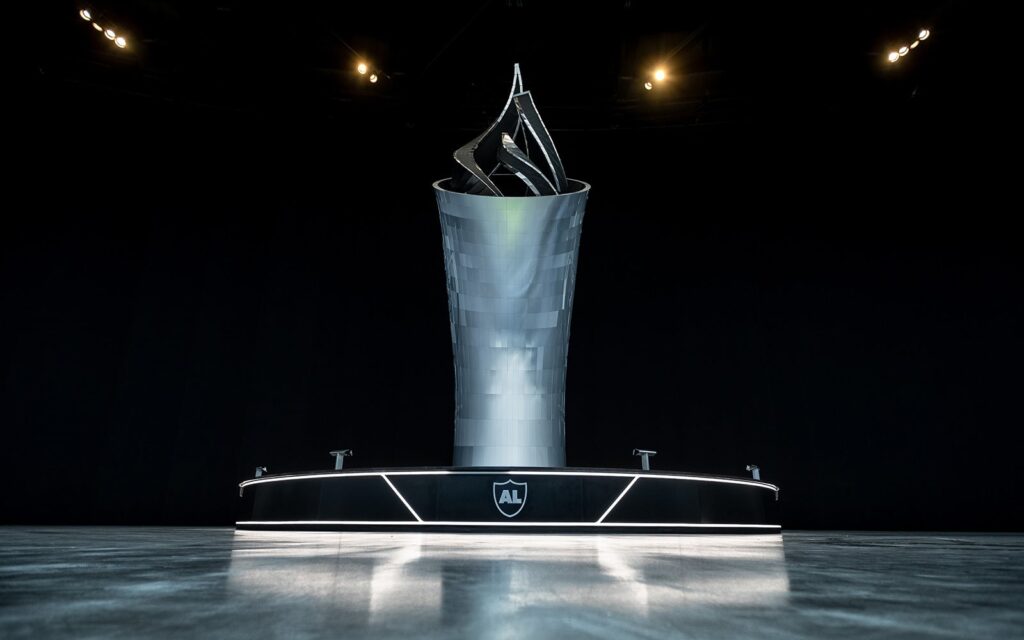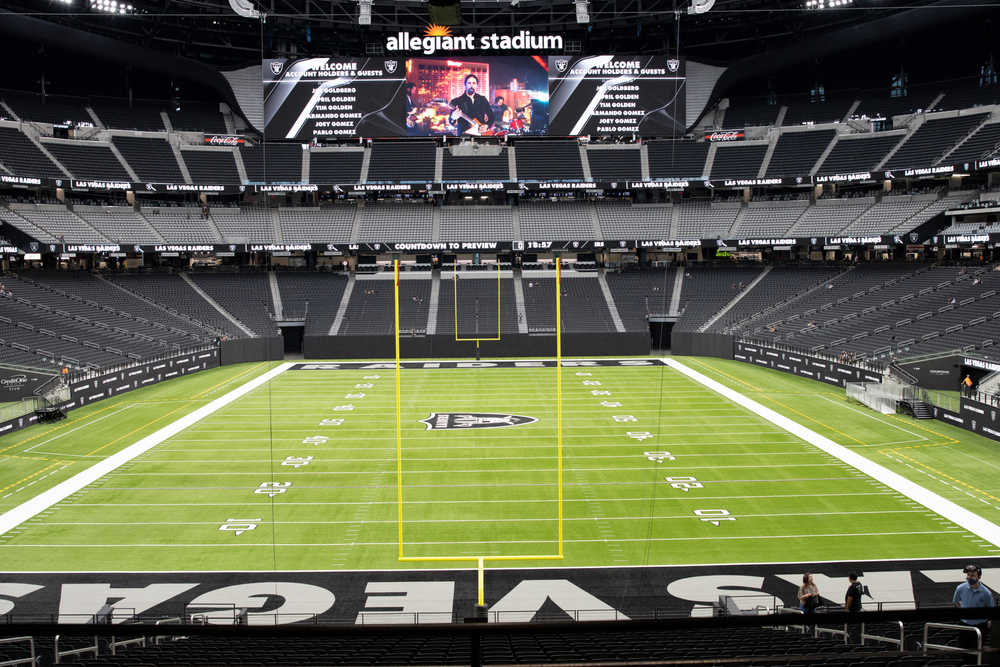Allegiant Stadium in Las Vegas, Nevada—home of the Las Vegas Raiders—will host Super Bowl LVIII on Sunday, February 11. There’s plenty to celebrate in this 3 ½-year-old venue, as it’s the first time the National Football League’s (NFL) biggest game is coming to Allegiant Stadium and the first time the Super Bowl is coming to the state of Nevada.

Whether you watch the Kansas City Chiefs battle it out with the San Francisco 49ers for the championship title from your favorite local bar or see all the action from the comfort of your home, you’ll be cheering on your favorite team (or perhaps second favorite if your team fumbled) and enjoying the halftime show. While the players are where the action is, facilities professionals around the world will be focused on the star of the show: Allegiant Stadium.
Stadium Stats
- Name: Allegiant Stadium
- Location: Las Vegas, Nevada
- Owner: Las Vegas Stadium Authority
- Cost: $2 billion
- Seating capacity: 65,000; can be expanded by 7,000 additional seats during major events
- Size: 1.8 million square feet
- Size (field event space): 95,000 square feet
- Concourse levels: 6
- Key building materials: 28,000 tons of structural steel and 105,000 cubic yards of concrete
- Notable features: Retractable natural turf field, large operable walls that open to views of the Las Vegas Strip, and a translucent roof
- Year opened: 2020
- Primary uses: Home of the Raiders and the University of Nevada, Las Vegas (UNLV) Rebels football teams
- Other uses: World-class entertainment, including concerts and special sporting events, such as the Pac-12 Championship Game, Las Vegas Bowl, and NFL Pro Bowl in 2022 and 2023
Construction Process
According to Arup, going “from concept design to completion in only 40 months, Allegiant Stadium is the fastest designed and constructed U.S. football stadium of its size,” adding that this was accomplished through a fast-track design-build delivery method.
Stadium officials say the construction project had “a remarkable safety record,” with a total recordable incident rate (TRIR) of only 0.98, less than one-third of the national average. More than 12,000 individuals contributed to the project’s design and construction, and more than 6 million labor hours went into the project.
Unique Features
Cable Net Truss System
One of the key features of this facility is the cable net truss system used for the weather-resistant and durable 7-acre ethylene tetrafluoroethylene roof, which is suspended by 100 stainless steel cables that create the lightweight roof structure diaphragm.
While this type of roof structure is unusual in the United States, it was necessary to achieve the architectural design.
“It is visually inspired by the sleek and gradual curves of a futuristic luxury vehicle, Allegiant Stadium is unlike any other venue, making it an architectural and engineering marvel,” according to a stadium press release.
Retractable Field System
Allegiant Stadium has a retractable field system weighing almost 20 million pounds. This system operates on a movable tray with 540 electronically powered wheels, which allows the 220-foot-wide natural grass field to move outdoors for sunlight and water. It takes 65 minutes to fully move the tray in or out of the stadium. When the field is returned, columns are put back using hydraulic actuators.
The Raiders favor the roll-in grass field, while the Rebels like to play on the artificial turf.
Al Davis Memorial Torch
The facility also features the Al Davis Memorial Torch, which is the largest free-standing 3D-printed structure in the world. It’s 93 feet tall and constructed of 225 3D-printed blocks made of carbon fiber-reinforced polycarbonate, each weighing about 350 pounds.

Before each game, teams and fans pay tribute to Davis by lighting the torch in his honor. Davis was the Raiders’ long-time owner, a Pro Football Hall of Fame inductee, an American Football League (AFL) Coach of the Year, and an AFL commissioner who passed away in 2011.
Sustainability
LEED Gold Certification
In July 2023, Allegiant Stadium was awarded the Leadership in Energy and Environmental Design (LEED) Gold Certification by the U.S. Green Building Council (USGBC). It’s only one of seven NFL stadiums to achieve LEED certification.
Several areas where its sustainability efforts excelled were noted on the LEED certification application, including:
- Materials and resources—for enhanced waste diversion practices, material donations from the community, and a green product purchasing policy.
- Sustainable sites—for its integrated pest management planning, minimizing herbicide and pesticide use, minimizing air pollution from maintenance equipment, reducing stormwater runoff, and invasive species control.
- Water efficiency—for utilization of high-efficiency faucets and toilet fixtures, actively monitoring water use for improved efficiencies, and minimal landscape irrigation.
- Energy and atmosphere—for its use of low-impact refrigerants, energy-efficient LED lighting, robust systems monitoring and management, and maximized efficiency in indoor climate control.
- Indoor environmental quality—for a robust tobacco- and smoke-free policy, rigorous green cleaning protocols, effective ventilation for improved air circulation, low-impact materials, and high visitor satisfaction feedback.
- Transportation—for its advocacy for and availability to pedestrians, shuttle services to and from nearby hotels, adjacent public transit express bus stops, and isolated ride-share pickup and drop-off locations.
“Allegiant Stadium is thrilled to reach the tremendous achievement of LEED Gold Certification for our sustainability efforts,” said Samantha Johnson, SVP of sales and leader of the sustainability efforts at Allegiant Stadium.
100% Renewable Energy
In October 2023, the stadium announced it converted to 100% renewable energy in partnership with utility NV Energy, making it the first NFL stadium powered exclusively by renewables.
“The Las Vegas Raiders are proud to set the bar in sustainability not only for the NFL but for sports around the world,” said Raiders President Sandra Douglass Morgan. “We have a responsibility to our fans, players, community, and planet to tackle sustainability head-on and set a new standard for sustainability in sports.”
Security
Operations Center and Command Center
Security is important at Allegiant Stadium year-round. The stadium has state-of-the-art life safety and security systems. Johnson Controls provided the stadium with configurable security management, access control, video management, vehicle security detection, and fire alarm detection and suppression. These solutions allow security to work with the Las Vegas Metropolitan Police Department (LVMPD) in sharing video feeds during stadium events.

The system includes a Gameday Operations Center with 15 to 20 operations personnel from various agencies, including the LVMPD, while the command center has security agencies, Raiders team operations, medical representatives, maintenance, parking, and other staff.
Additional Super Bowl Security
Having top-notch security is vital for the Super Bowl. As Allegiant Stadium prepares for the championship game, additional security measures will include:
- A 300-foot security perimeter requiring all vehicles to be X-ray scanned about a mile away from the stadium;
- A new area where vehicles can drop off passengers;
- Restricted access to the employees of businesses in the stadium district;
- Information on road closures, lane restrictions, and traffic impacts via SMS; and
- Knowledge obtained through a cyberattack exercise helping them prepare for possible phishing, ransomware, data breach, or insider threats that could threaten the stadium.
Allegiant Stadium Scores the Touchdown!
Allegiant Stadium is one of the newest NFL stadiums, and its cable net truss system, retractable field system, Al Davis Memorial Torch, and sustainability and security systems make this facility one of a kind.
Additional information on Allegiant Stadium can be found by clicking here.
